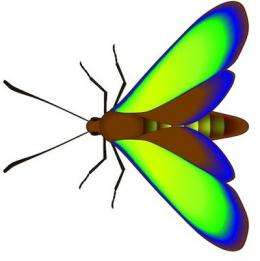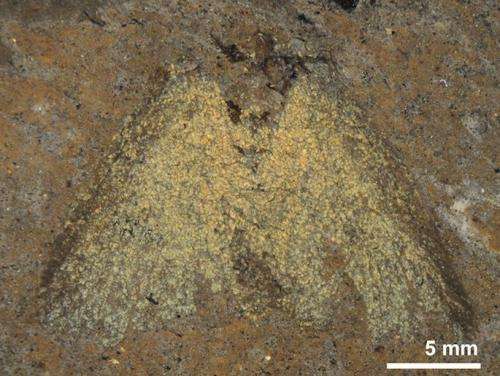Fossil moths show their true colors

The brightest hues in nature are produced by tiny patterns in, say, feathers or scales rather than pigments. These so-called "structural colors" are widespread, giving opals their fire, people their blue eyes, and peacocks their brilliant feathers. Many animals use this type of color for communication, notably butterflies and moths (Lepidoptera), which display the biggest range of structural colors and put them to uses from advertising their toxicity to choosing the best mates. But despite the importance of structural colors in their lives, little is known about how lepidopterans developed these key social signals. Now, in the Nov. 15 issue of PLoS Biology, palaeobiologist Maria McNamara (Yale University) and colleagues bring us closer to the origins of structural colors by reconstructing them in fossil moths that are 47 million years old.
This is the first evidence of structurally colored scales in fossil lepidopterans. The fossil moths came from the Messel oil shale in Germany, a site famous for exquisite fossil preservation.

Although the original colors of the fossil moths were not preserved, the researchers were able to reconstruct them because the tiny color-producing patterns in the moth scales were intact. "The level of detail preserved in the scales of the fossil moths is just spectacular", said McNamara. The fossil moths owe their color to a stack of layers inside the scales. These layers form a fossil multilayer reflector, which usually produces iridescent colour that changes depending on viewing angle. But other details of the fossil scales suppressed this effect, producing instead muted colors. "The moths basically wanted to appear the same colour from different angles – they didn't want flashy iridescence" said McNamara.
Today, the front wings of the ancient moths look mostly blue, presumably because the chemistry of the cuticle was altered during the process of fossilization. The researchers reconstructed the original colors via mathematical analysis of the scale ultrastructure, revealing that the wings had actually been yellow-green when the moths were alive. Modern butterflies and moths use bright, contrasting colors to communicate with each other, and muted greens to camouflage themselves in leafy habitats. This makes it likely that the fossil moths used their yellow-green wings to blend in with leaves, suggesting that this strategy for hiding in plain sight had evolved as early as 47 million years ago amongst lepidopterans.
The fossils are thought to be from extinct relatives of today's forester moths, which feed on flower nectar. If this was also true of these ancient moths, their yellow-green wings would have stood out while feeding. The researchers suggest that being easy to see on flowers could have served as a warning to predators. Modern forester moths can synthesize cyanide, making them taste bad, and their ancestors may have already developed this capability.
These findings shed light on the evolution of tactics for predator avoidance and deterrence in forester moths. In addition, by showing that the original structural colors of fossil moths can be reconstructed, this works leads the way toward finding the origins of the many ways butterfly and moth species use this type of color to communicate amongst each other as well as with predators. "Reconstructing the original colors of ancient animals gives us really good insights into their behaviour" said McNamara. "These moth fossils hint that we can even do this for fossils that don't have obvious color".
More information: McNamara ME, Briggs DEG, Orr PJ, Wedmann S, Noh H, et al. (2011) Fossilized Biophotonic Nanostructures Reveal the Original Colors of 47-Million-Year-Old Moths. PLoS Biol 9(11): e1001200. doi:10.1371/journal.pbio.1001200
Provided by Public Library of Science



















